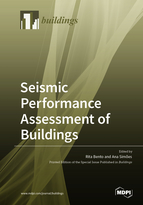Seismic Performance Assessment of Buildings
A special issue of Buildings (ISSN 2075-5309). This special issue belongs to the section "Building Structures".
Deadline for manuscript submissions: closed (15 February 2021) | Viewed by 27444
Special Issue Editors
Interests: seismic vulnerability assessment; masonry buildings; reinforced concrete buildings; protection of cultural heritage; strengthening; structural testing; nonlinear modelling
Special Issues, Collections and Topics in MDPI journals
Special Issue Information
Dear Colleagues,
This Special Issue aims to provide a forum for presenting and discussing the latest findings and developments in the area of seismic performance assessment of buildings. It is well known that earthquakes are catastrophic events inducing major human and economic losses. Seismic performance assessment is a formal process for the seismic upgrade of existing buildings which includes a specific intent to achieve defined performance objectives in future earthquakes. It requires basic data on the vulnerability of structural and nonstructural components to damage (fragility), as well as estimates of potential casualties, repair costs, repair times, and environmental impacts (consequences) associated with this damage.
The aim of this Special Issue is to attract world-leading researchers in the area and to help them spread their latest developments, including new methodologies for the seismic performance assessment of buildings, numerical modeling, and the definition of performance objectives and estimates of the consequences both at the building and urban scale.
It is the hope of the Editorial Team that this Special Issue will contribute to advancing the state-of-the-art towards seismic performance assessment and improvement of buildings.
Prof. Dr. Rita Bento
Dr. Ana Simões
Guest Editors
Manuscript Submission Information
Manuscripts should be submitted online at www.mdpi.com by registering and logging in to this website. Once you are registered, click here to go to the submission form. Manuscripts can be submitted until the deadline. All submissions that pass pre-check are peer-reviewed. Accepted papers will be published continuously in the journal (as soon as accepted) and will be listed together on the special issue website. Research articles, review articles as well as short communications are invited. For planned papers, a title and short abstract (about 100 words) can be sent to the Editorial Office for announcement on this website.
Submitted manuscripts should not have been published previously, nor be under consideration for publication elsewhere (except conference proceedings papers). All manuscripts are thoroughly refereed through a single-blind peer-review process. A guide for authors and other relevant information for submission of manuscripts is available on the Instructions for Authors page. Buildings is an international peer-reviewed open access monthly journal published by MDPI.
Please visit the Instructions for Authors page before submitting a manuscript. The Article Processing Charge (APC) for publication in this open access journal is 2600 CHF (Swiss Francs). Submitted papers should be well formatted and use good English. Authors may use MDPI's English editing service prior to publication or during author revisions.
Keywords
- Seismic performance assessment
- Vulnerability analysis
- Fragility analysis
- Loss
- Seismic risk
- Masonry buildings
- RC buildings
- Mixed buildings
- Monumental buildings







